Abstract
1. The responses of the post-synaptic membrane of sympathetic ganglion cells to noradrenaline (NA) and to acetylcholine (ACh) were studied in relation to the slow inhibitory post-synaptic potential (S-IPSP) and slow excitatory one (S-EPSP) respectively.
2. NA produced an hyperpolarization of about 4 mV in cells of rabbit superior cervical ganglia.
3. The hyperpolarizing response to NA was not accompanied by any detectable change in membrane resistance, and it was depressed by conditioning depolarization.
4. NA also depressed all the post-synaptic potentials, presumably by an action on presynaptic function.
5. ACh produced a large depolarization in ganglion cells of rabbit and of frog (paravertebral) ganglia, which was accompanied by a large decrease in membrane resistance.
6. When ACh was applied during nicotinic blockade, achieved with high concentration of nicotine (frog ganglia) or D-tubocurarine (rabbit ganglia), it still produced a considerable depolarization. This response could be blocked by atropine, and is presumably a muscarinic type of action.
7. The muscarinic-ACh response was not accompanied by a decrease in membrane resistance. Instead, the frog ganglion cells exhibited increased resistances of up to more than twice the resting value during both the muscarinic-ACh depolarization and the S-EPSP.
8. The muscarinic-ACh depolarization and the S-EPSP were both depressed by conditioning hyperpolarization (in nicotinized frog cells). An initial hyperpolarizing phase now appeared in both of these responses.
9. It is concluded that the hyperpolarizing response to NA and the depolarizing response to muscarinic-ACh action are not generated by increases in ionic mobilities in the post-synaptic membrane; and that these two responses are produced by the same electrogenic mechanisms which underlie the S-IPSP and the S-EPSP respectively.
Full text
PDF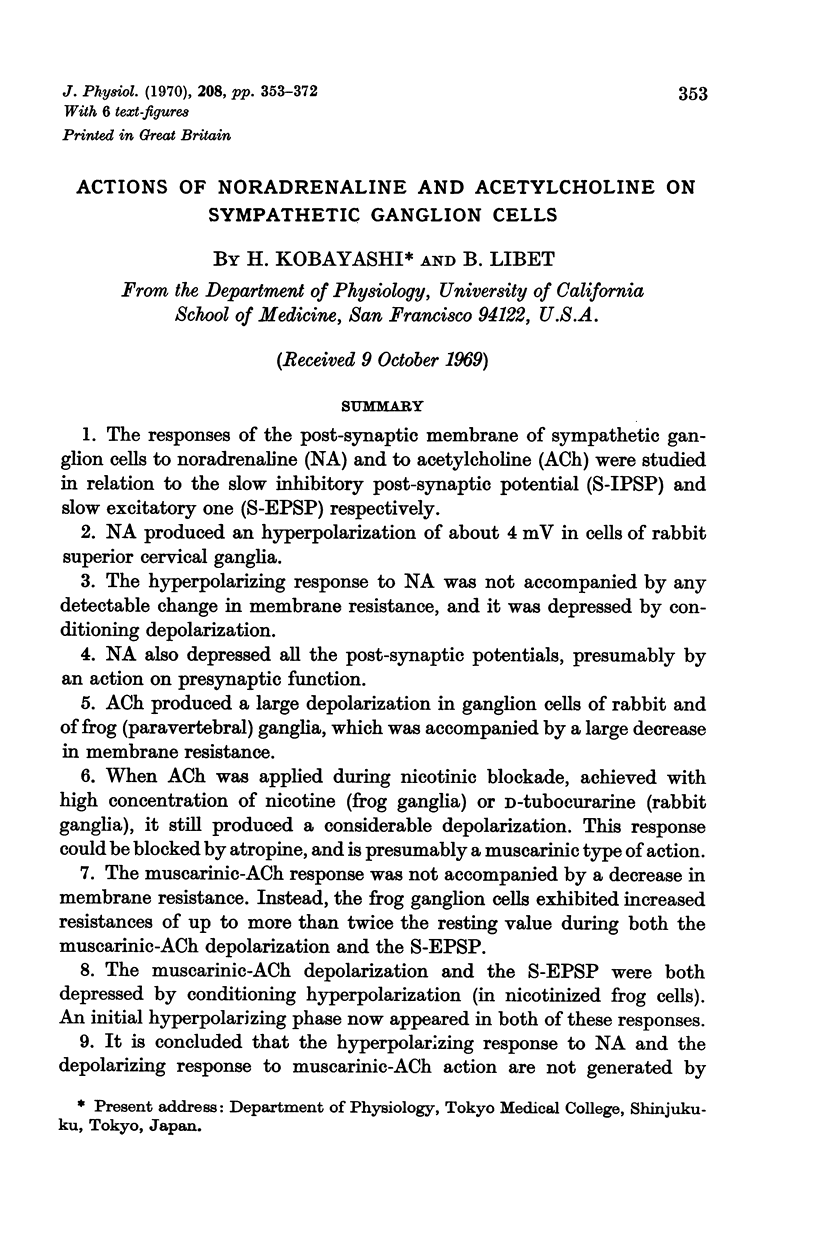

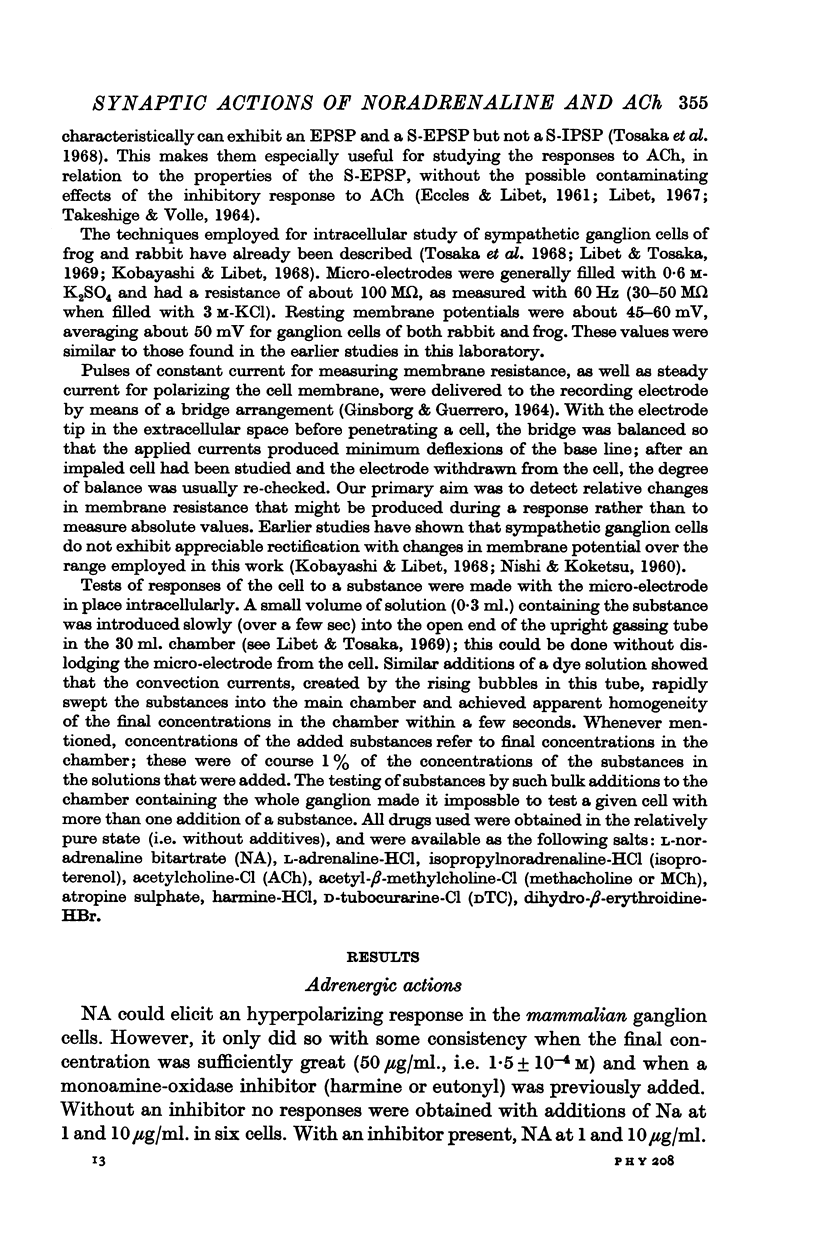
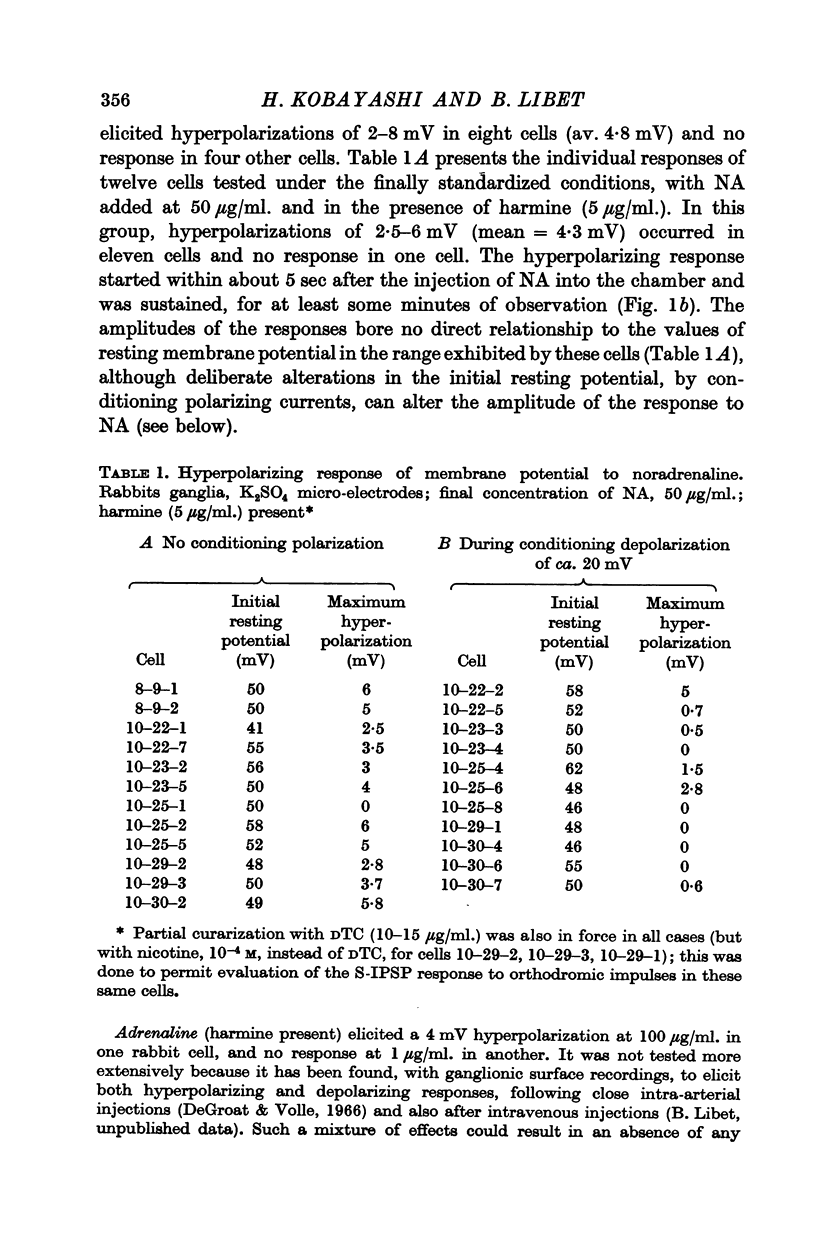


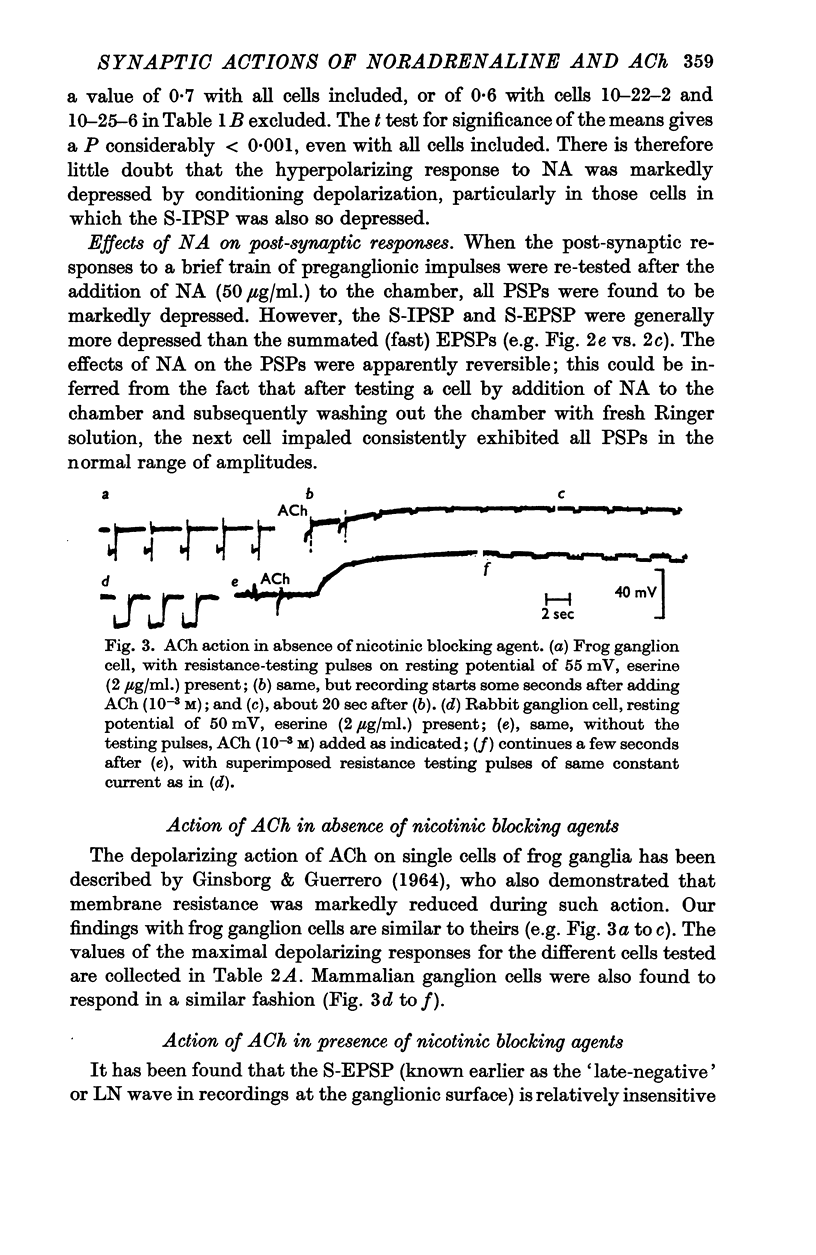
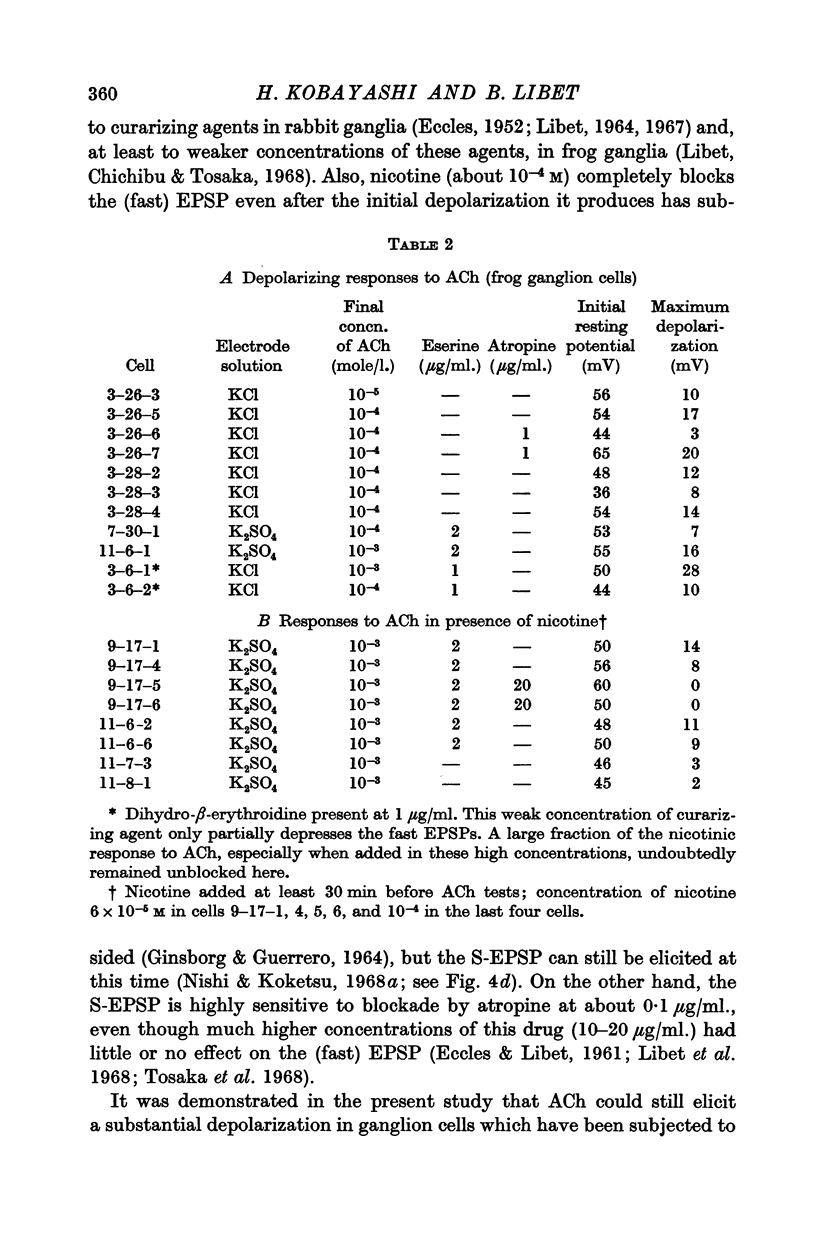
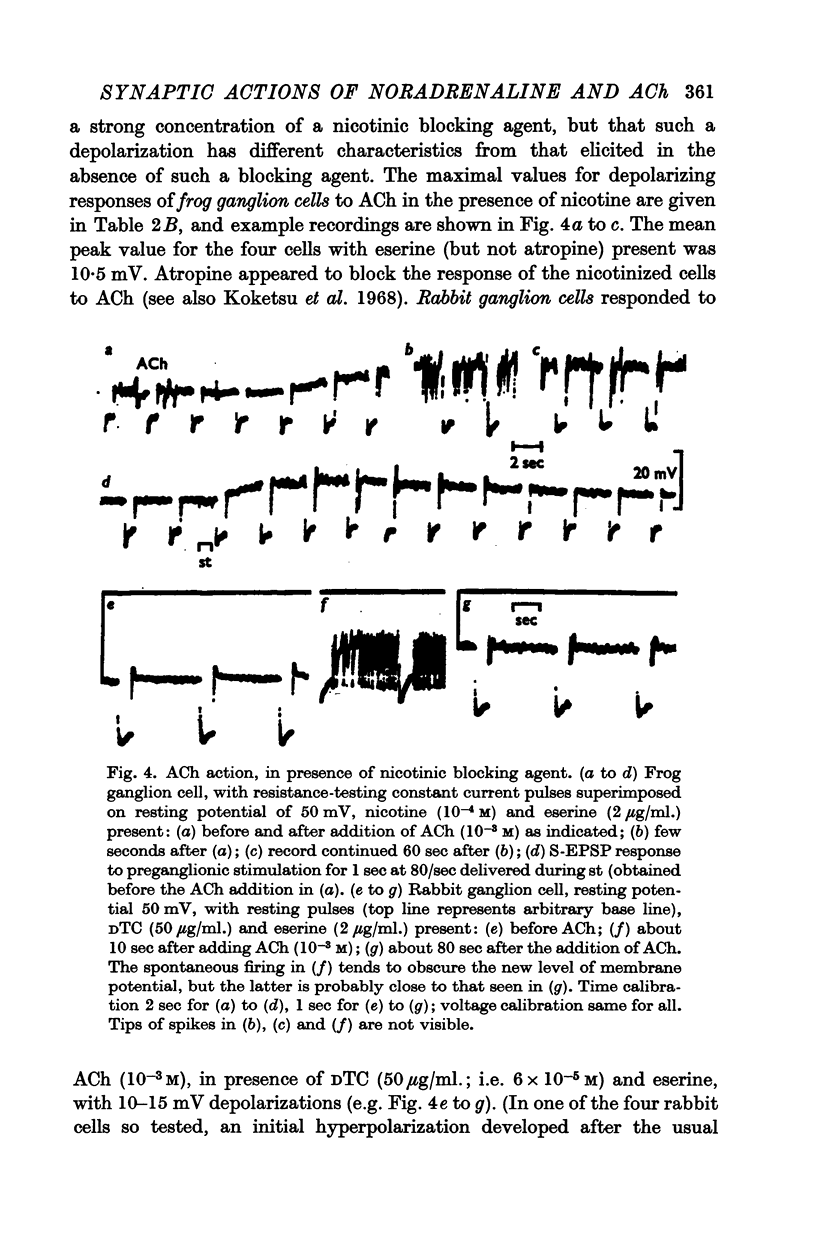
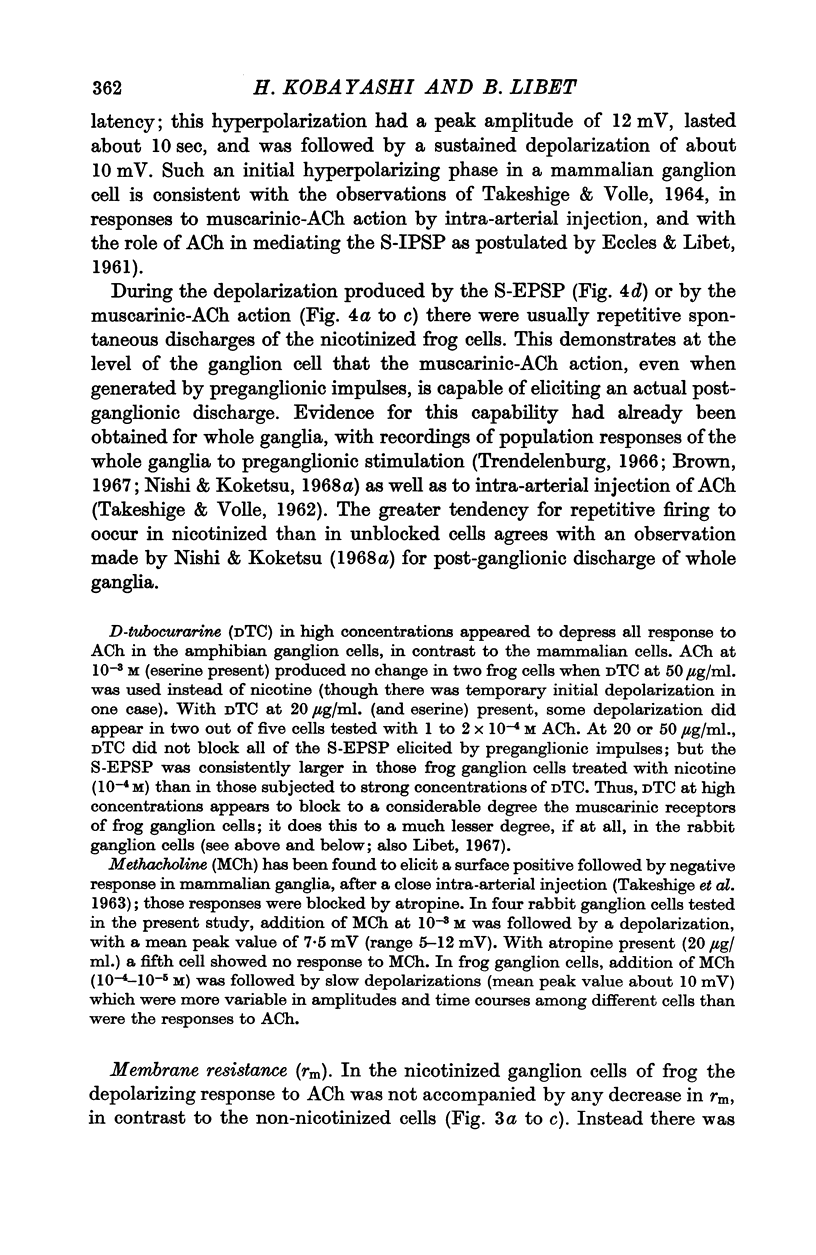
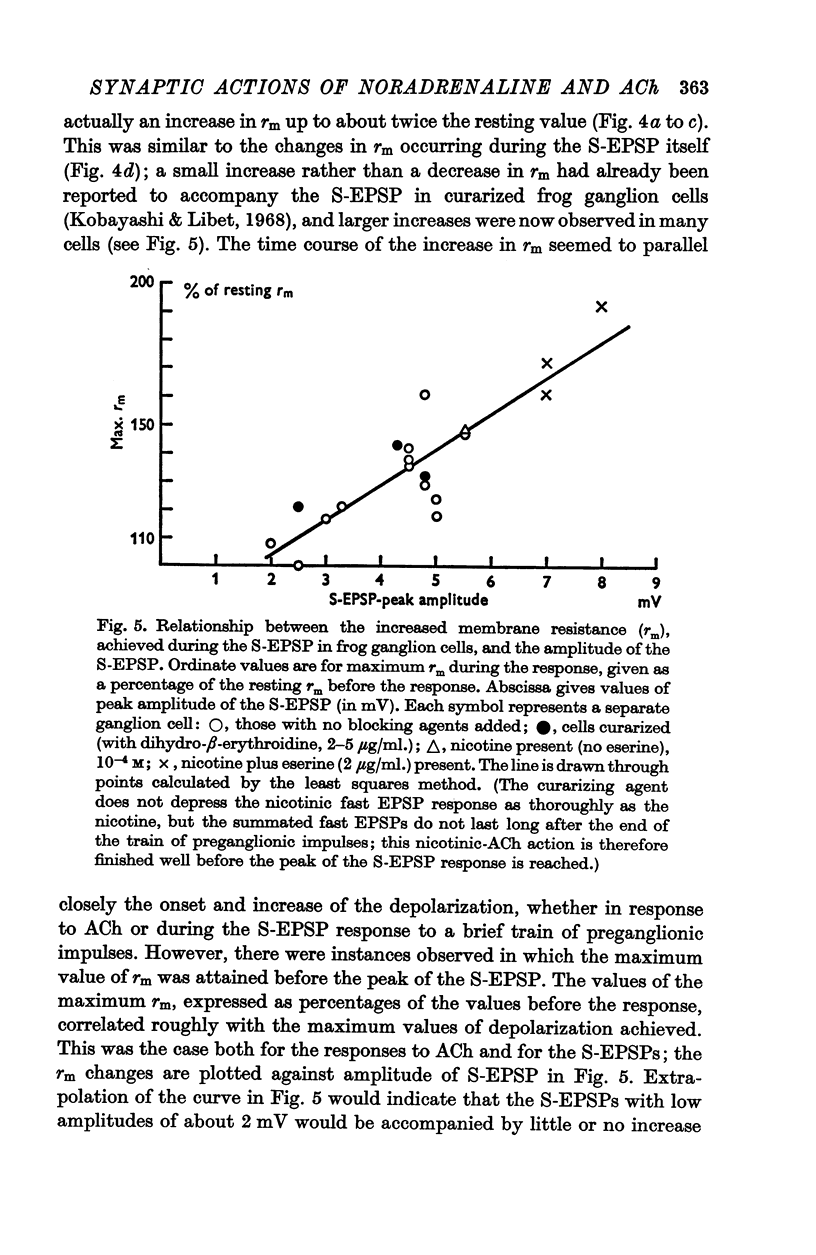
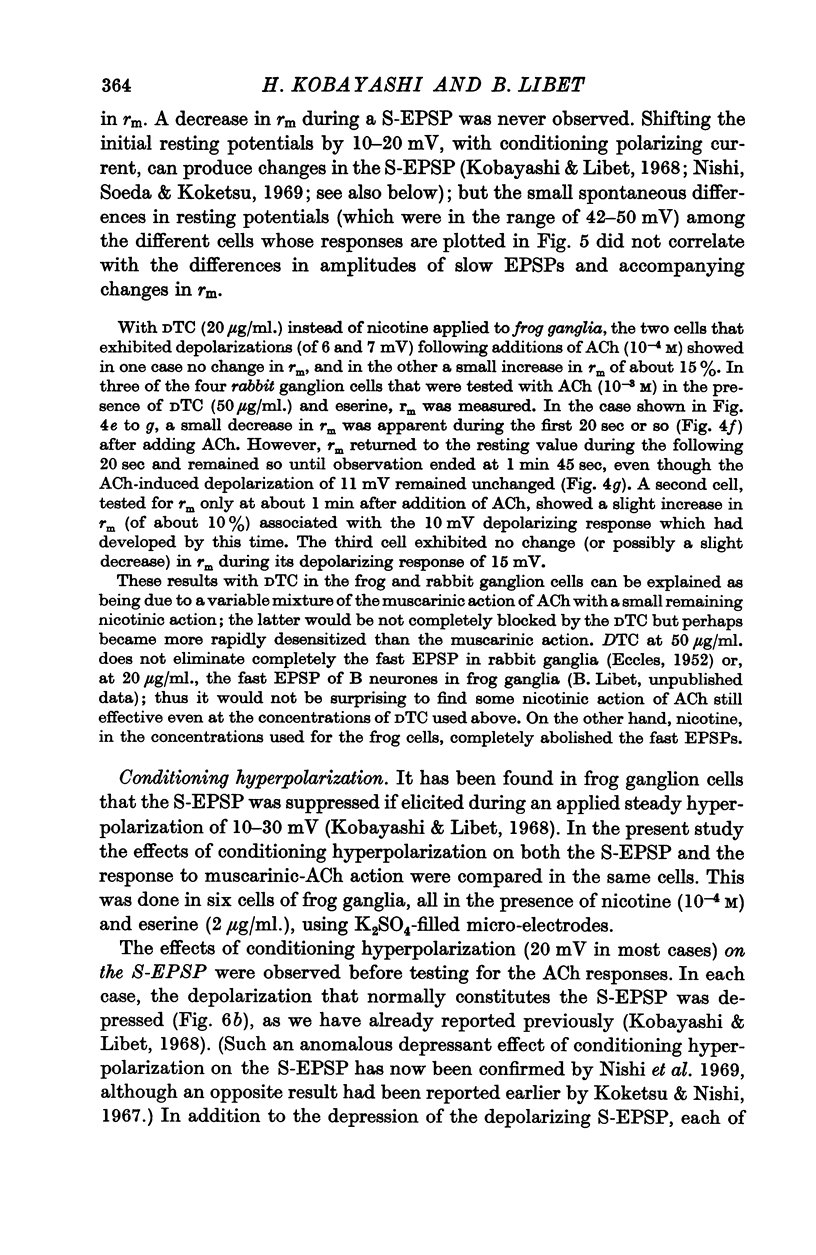
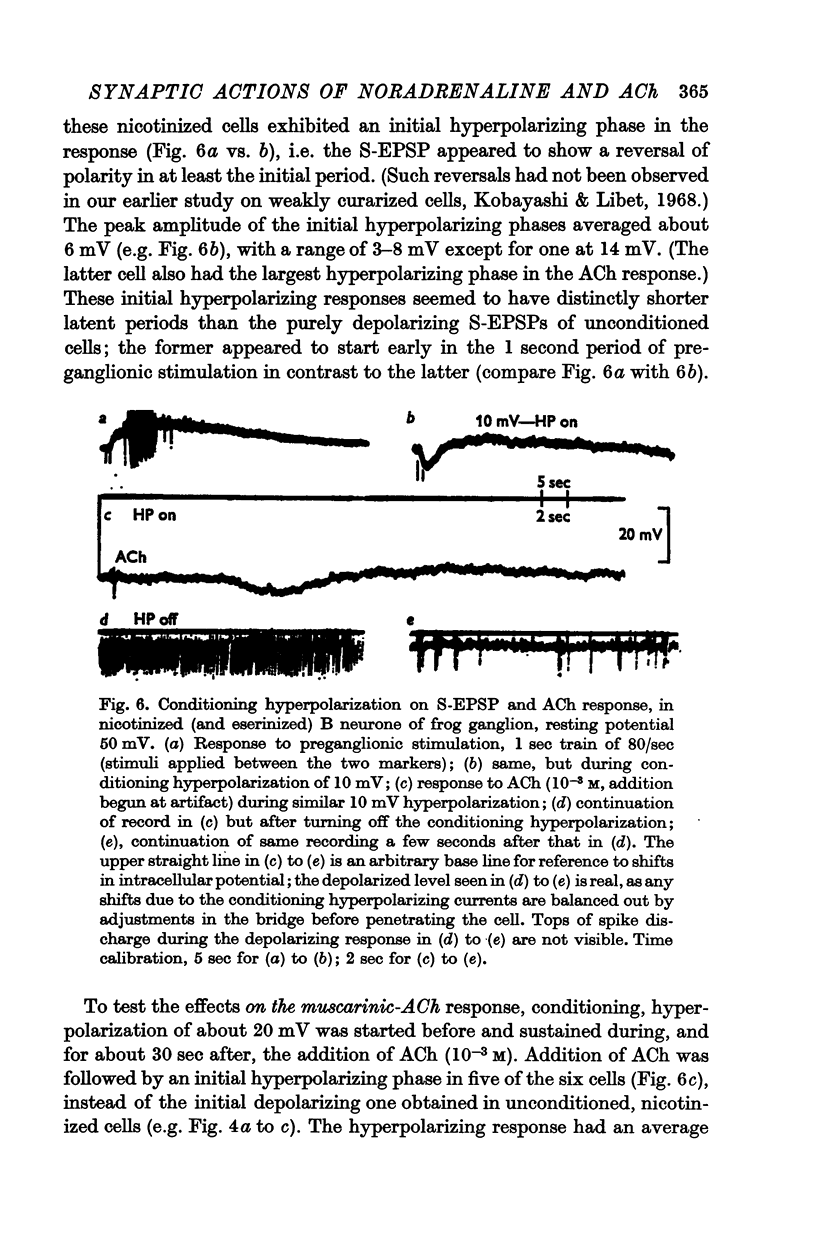
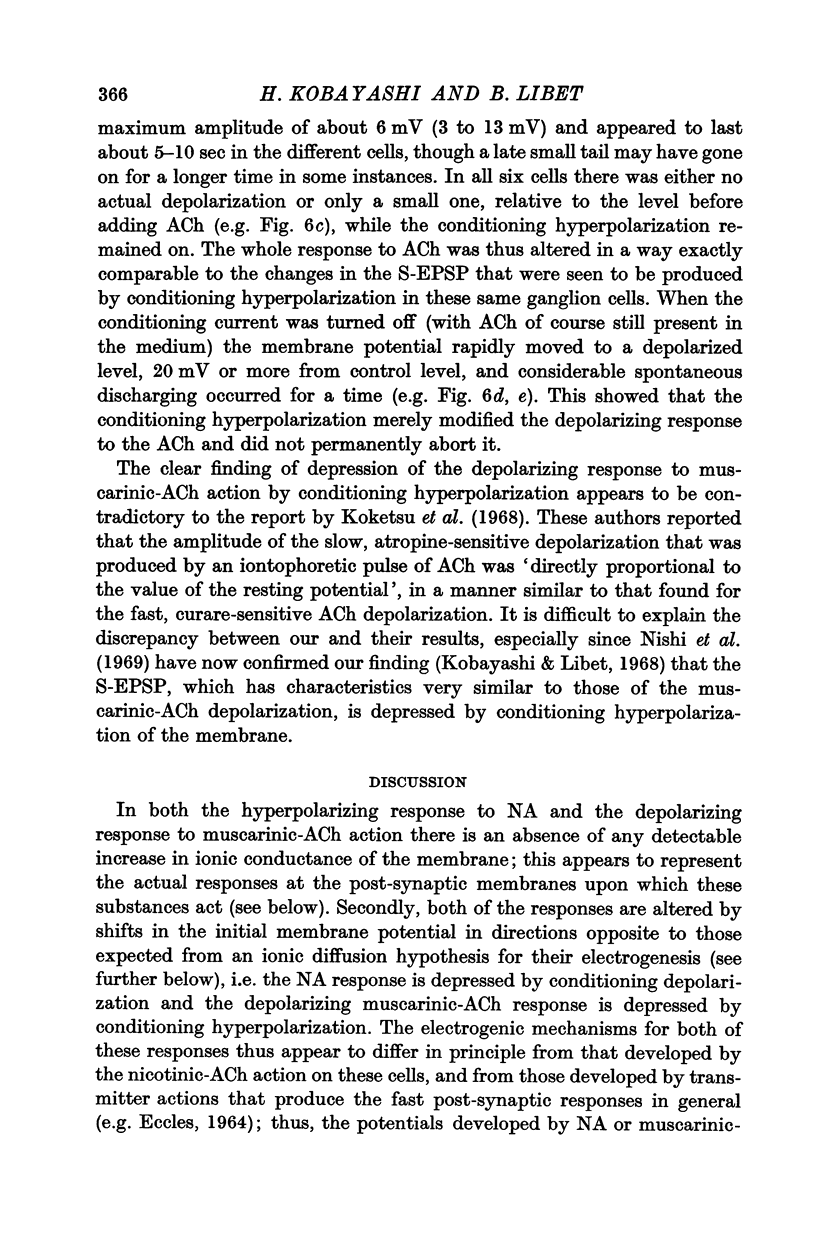
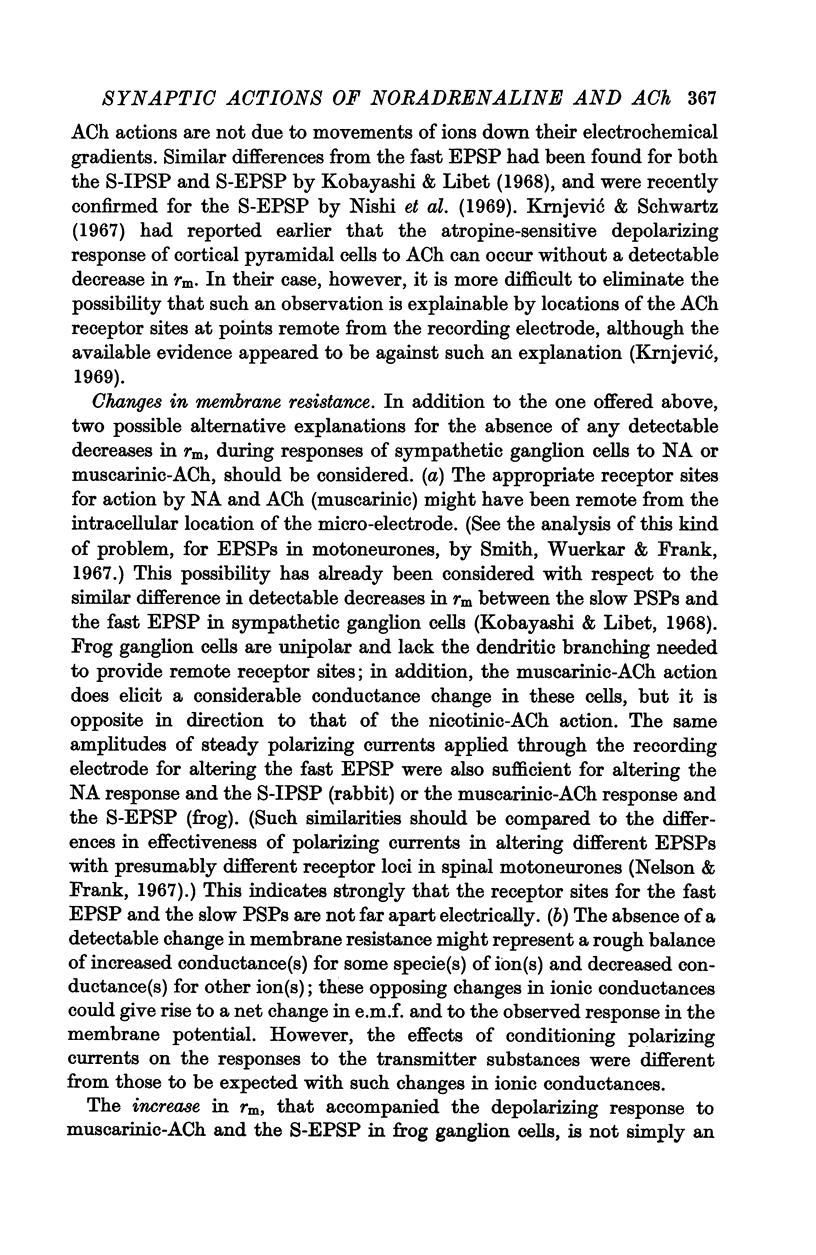
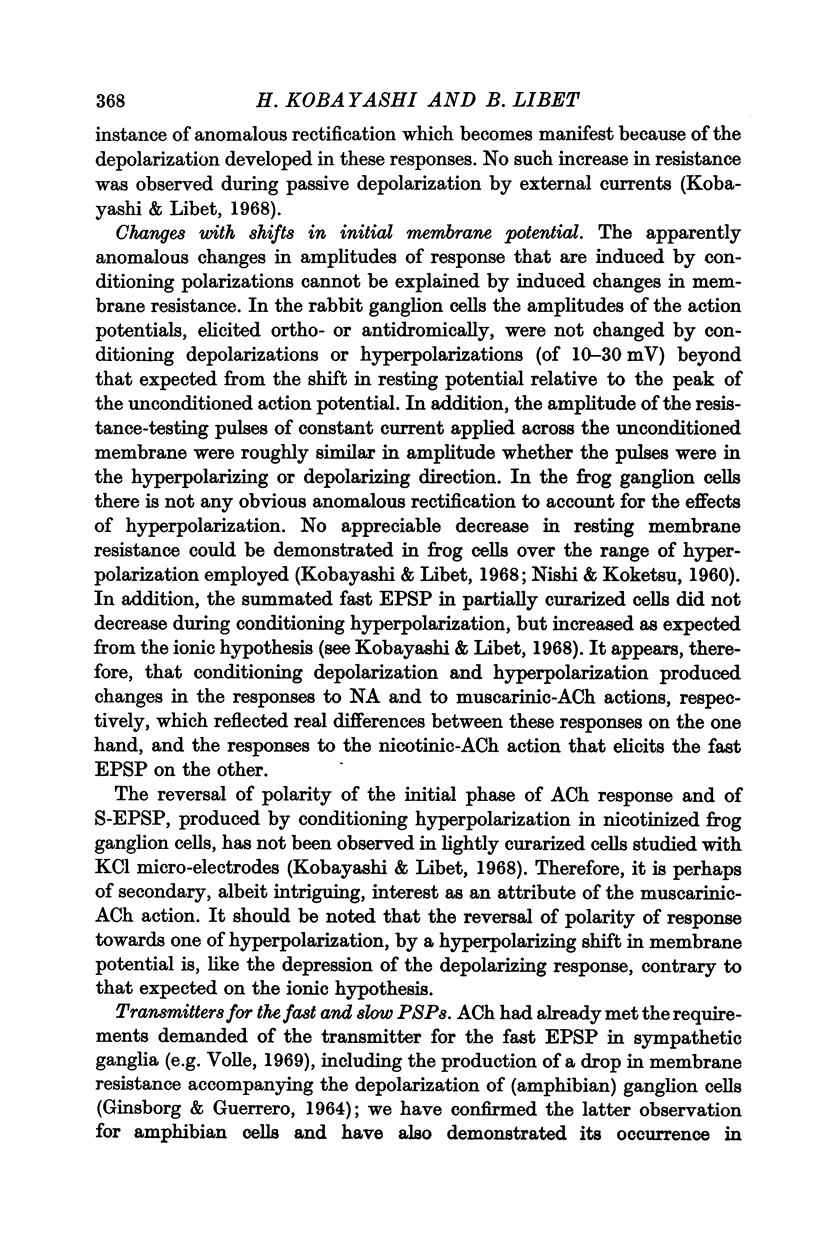
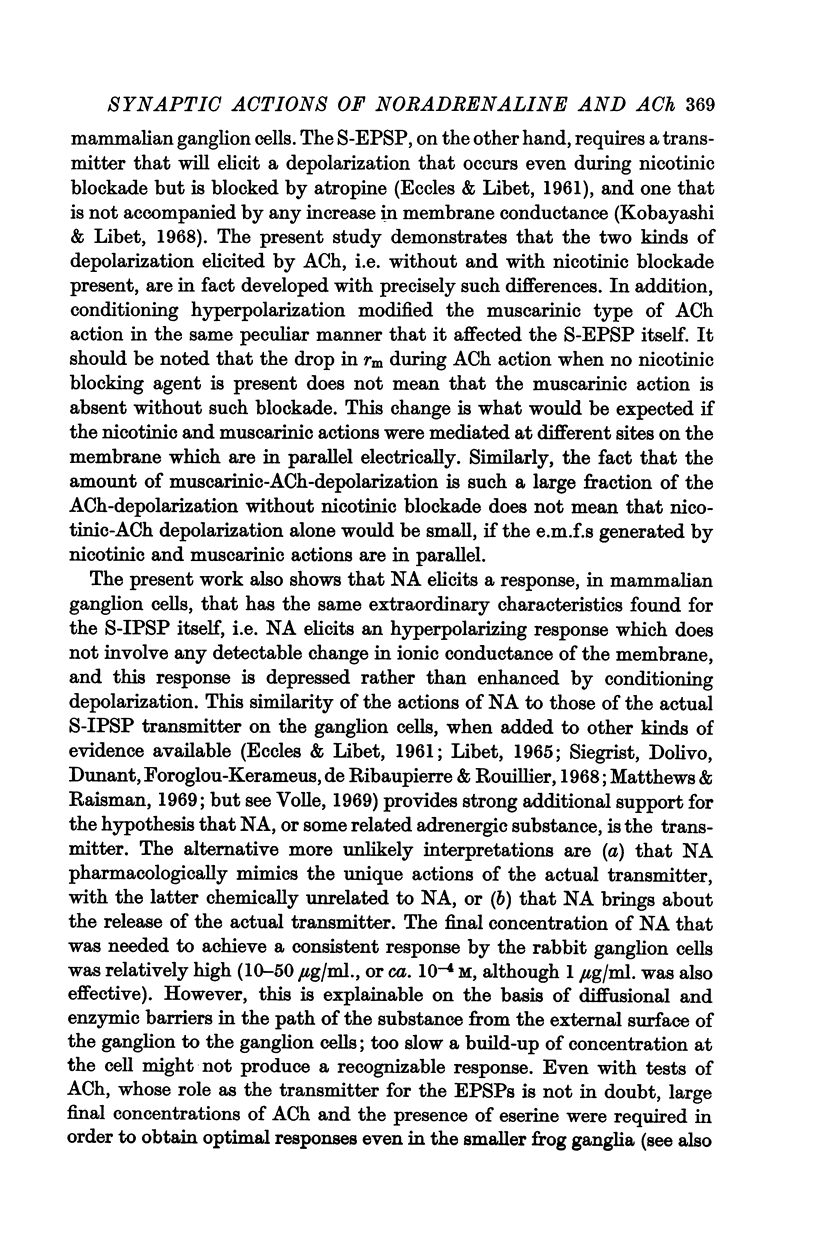
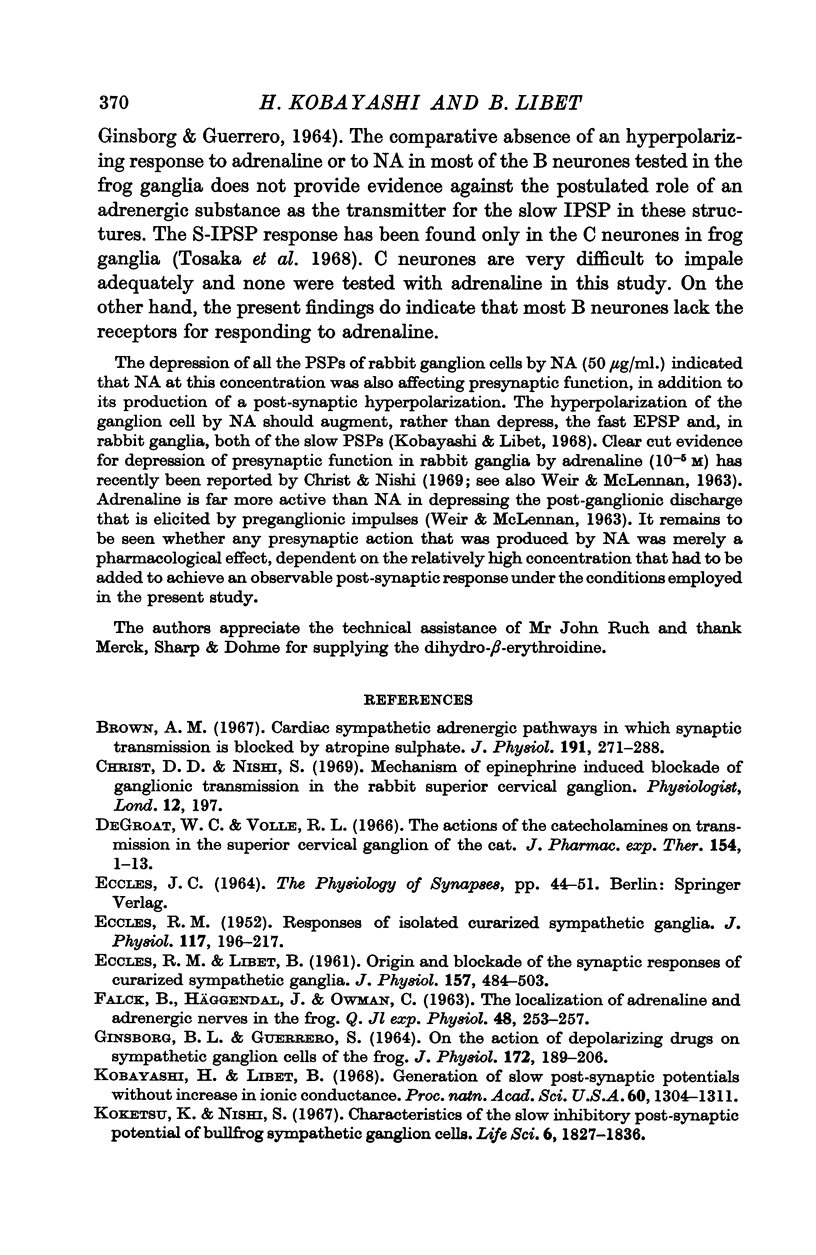
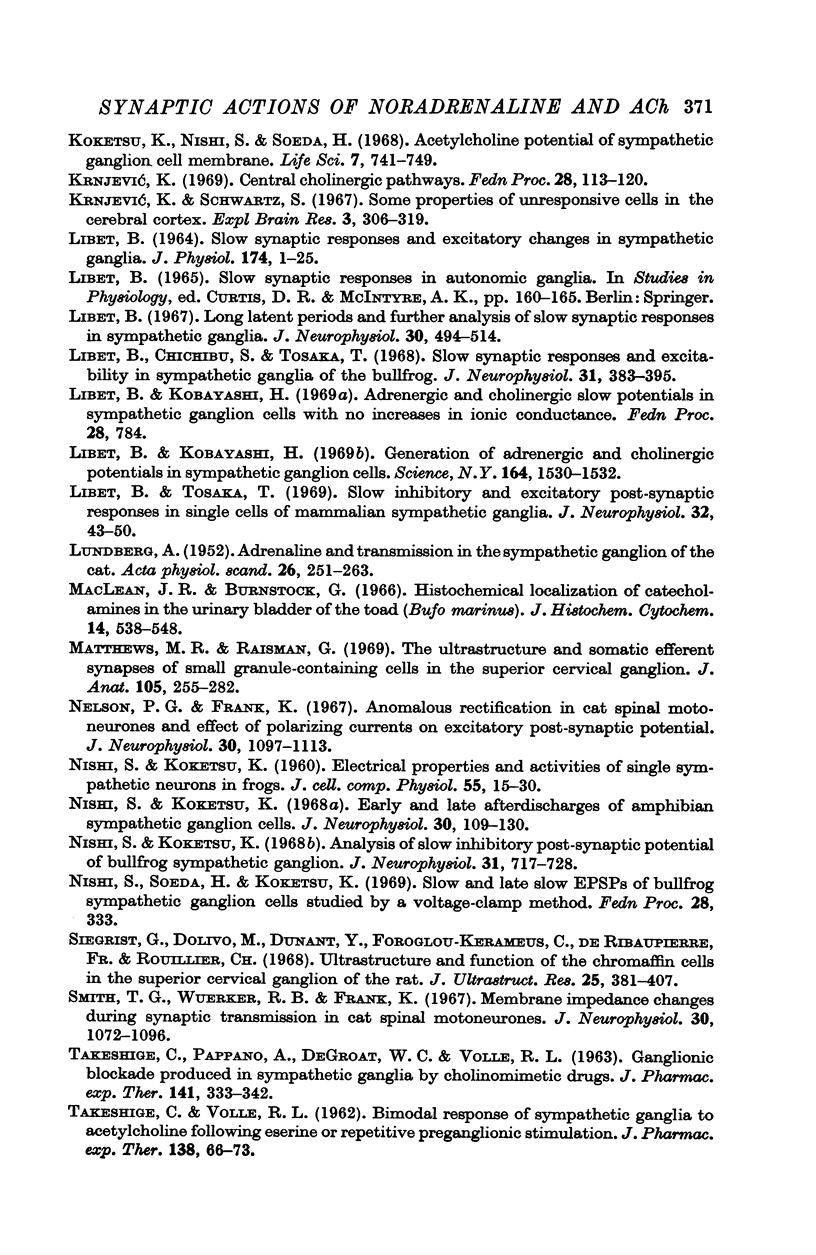
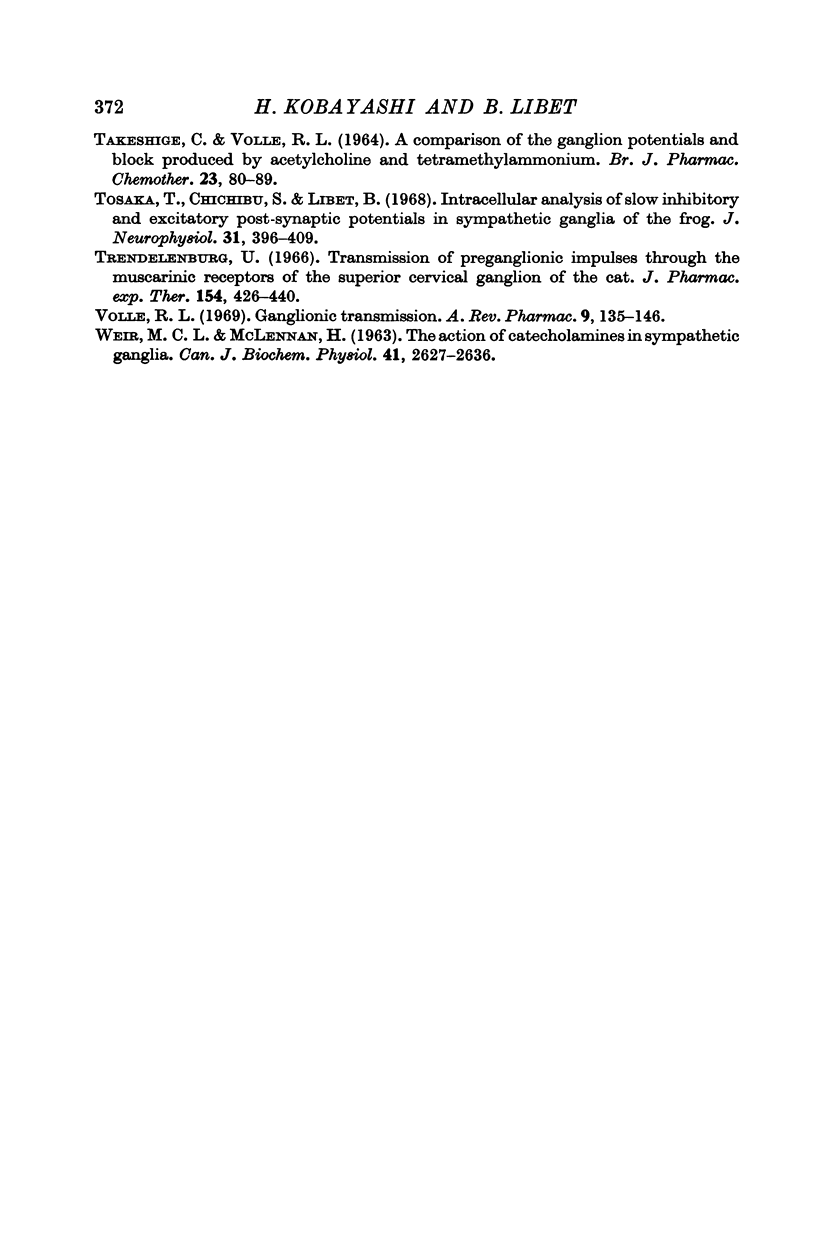
Selected References
These references are in PubMed. This may not be the complete list of references from this article.
- Brown A. M. Cardiac sympathetic adrenergic pathways in which synaptic transmission is blocked by atropine sulfate. J Physiol. 1967 Jul;191(2):271–288. doi: 10.1113/jphysiol.1967.sp008250. [DOI] [PMC free article] [PubMed] [Google Scholar]
- De Groat W. C., Volle R. L. The actions of the catecholamines on transmission in the superior cervical ganglion of the cat. J Pharmacol Exp Ther. 1966 Oct;154(1):1–13. [PubMed] [Google Scholar]
- ECCLES R. M., LIBET B. Origin and blockade of the synaptic responses of curarized sympathetic ganglia. J Physiol. 1961 Aug;157:484–503. doi: 10.1113/jphysiol.1961.sp006738. [DOI] [PMC free article] [PubMed] [Google Scholar]
- ECCLES R. Responses of isolated curarized sympathetic ganglia. J Physiol. 1952 Jun;117(2):196–217. doi: 10.1113/jphysiol.1952.sp004740. [DOI] [PMC free article] [PubMed] [Google Scholar]
- GINSBORG B. L., GUERRERO S. ON THE ACTION OF DEPOLARIZING DRUGS ON SYMPATHETIC GANGLION CELLS OF THE FROG. J Physiol. 1964 Aug;172:189–206. doi: 10.1113/jphysiol.1964.sp007412. [DOI] [PMC free article] [PubMed] [Google Scholar]
- Kobayashi H., Libet B. Generation of slow postsynaptic potentials without increases in ionic conductance. Proc Natl Acad Sci U S A. 1968 Aug;60(4):1304–1311. doi: 10.1073/pnas.60.4.1304. [DOI] [PMC free article] [PubMed] [Google Scholar]
- Koketsu K., Nishi S. Characteristics of the slow inhibitory postsynaptic potential of bullfrog sympathetic ganglion cells. Life Sci. 1967 Sep 1;6(17):1827–1836. doi: 10.1016/0024-3205(67)90211-1. [DOI] [PubMed] [Google Scholar]
- Krnjević K., Schwartz S. Some properties of unresponsive cells in the cerebral cortex. Exp Brain Res. 1967;3(4):306–319. doi: 10.1007/BF00237557. [DOI] [PubMed] [Google Scholar]
- LIBET B. SLOW SYNAPTIC RESPONSES AND EXCITATORY CHANGES IN SYMPATHETIC GANGLIA. J Physiol. 1964 Oct;174:1–25. doi: 10.1113/jphysiol.1964.sp007471. [DOI] [PMC free article] [PubMed] [Google Scholar]
- LUNDBERG A. Adrenaline and transmission in the sympathetic ganglion of the cat. Acta Physiol Scand. 1952 Sep 10;26(2-3):252–263. doi: 10.1111/j.1748-1716.1952.tb00908.x. [DOI] [PubMed] [Google Scholar]
- Libet B., Chichibu S., Tosaka T. Slow synaptic responses and excitability in sympathetic ganglia of the bullfrog. J Neurophysiol. 1968 May;31(3):383–395. doi: 10.1152/jn.1968.31.3.383. [DOI] [PubMed] [Google Scholar]
- Libet B., Kobayashi H. Generation of adrenergic and cholinergic potentials in sympathetic ganglion cells. Science. 1969 Jun 27;164(3887):1530–1532. doi: 10.1126/science.164.3887.1530. [DOI] [PubMed] [Google Scholar]
- Libet B. Long latent periods and further analysis of slow synaptic responses in sympathetic ganglia. J Neurophysiol. 1967 May;30(3):494–514. doi: 10.1152/jn.1967.30.3.494. [DOI] [PubMed] [Google Scholar]
- Libet B., Tosaka T. Slow inhibitory and excitatory postsynaptic responses in single cells of mammalian sympathetic ganglia. J Neurophysiol. 1969 Jan;32(1):43–50. doi: 10.1152/jn.1969.32.1.43. [DOI] [PubMed] [Google Scholar]
- Matthews M. R., Raisman G. The ultrastructure and somatic efferent synapses of small granule-containing cells in the superior cervical ganglion. J Anat. 1969 Sep;105(Pt 2):255–282. [PMC free article] [PubMed] [Google Scholar]
- McLean J. R., Burnstock G. Histochemical localization of catecholamines in the urinary bladder of the toad (Bufo marinus). J Histochem Cytochem. 1966 Jul;14(7):538–548. doi: 10.1177/14.7.538. [DOI] [PubMed] [Google Scholar]
- NISHI S., KOKETSU K. Electrical properties and activities of single sympathetic neurons in frogs. J Cell Comp Physiol. 1960 Feb;55:15–30. doi: 10.1002/jcp.1030550104. [DOI] [PubMed] [Google Scholar]
- Nelson P. G., Frank K. Anomalous rectification in cat spinal motoneurons and effect of polarizing currents on excitatory postsynaptic potential. J Neurophysiol. 1967 Sep;30(5):1097–1113. doi: 10.1152/jn.1967.30.5.1097. [DOI] [PubMed] [Google Scholar]
- Nishi S., Koketsu K. Analysis of slow inhibitory postsynaptic potential of bullfrog sympathetic ganglion. J Neurophysiol. 1968 Sep;31(5):717–728. doi: 10.1152/jn.1968.31.5.717. [DOI] [PubMed] [Google Scholar]
- Siegrist G., Dolivo M., Dunant Y., Foroglou-Kerameus C., De Ribaupierre F., Rouiller C. Ultrastructure and function of the chromaffin cells in the superior cervical ganglion of the rat. J Ultrastruct Res. 1968 Dec;25(5):381–407. doi: 10.1016/s0022-5320(68)80093-0. [DOI] [PubMed] [Google Scholar]
- Smith T. G., Wuerker R. B., Frank K. Membrane impedance changes during synaptic transmission in cat spinal motoneurons. J Neurophysiol. 1967 Sep;30(5):1072–1096. doi: 10.1152/jn.1967.30.5.1072. [DOI] [PubMed] [Google Scholar]
- TAKESHIGE C., PAPPANO A. J., DEGROAT W. C., VOLLE R. L. GANGLIONIC BLOCKADE PRODUCED IN SYMPATHETIC GANGLIA BY CHOLINOMIMETIC DRUGS. J Pharmacol Exp Ther. 1963 Sep;141:333–342. [PubMed] [Google Scholar]
- TAKESHIGE C., VOLLE R. L. A COMPARISON OF THE GANGLION POTENTIALS AND BLOCK PRODUCED BY ACETYLCHOLINE AND TETRAMETHYLAMMONIUM. Br J Pharmacol Chemother. 1964 Aug;23:80–89. doi: 10.1111/j.1476-5381.1964.tb01568.x. [DOI] [PMC free article] [PubMed] [Google Scholar]
- TAKESHIGE C., VOLLE R. L. Bimodal response of sympathetic ganglia to acetylcholine following eserine or repetitive preganglionic stimulation. J Pharmacol Exp Ther. 1962 Oct;138:66–73. [PubMed] [Google Scholar]
- Tosaka T., Chichibu S., Libet B. Intracellular analysis of slow inhibitors and excitatory postsynaptic potentials in sympathetic ganglia of the frog. J Neurophysiol. 1968 May;31(3):396–409. doi: 10.1152/jn.1968.31.3.396. [DOI] [PubMed] [Google Scholar]
- Trendelenburg U. Transmission of preganglionic impulses through the muscarinic receptors of the superior cervical ganglion of the cat. J Pharmacol Exp Ther. 1966 Dec;154(3):426–440. [PubMed] [Google Scholar]
- WEIR M. C., MCLENNAN H. THE ACTION OF CATECHOLAMINES IN SYMPATHETIC GANGLIA. Can J Biochem Physiol. 1963 Dec;41:2627–2636. [PubMed] [Google Scholar]


